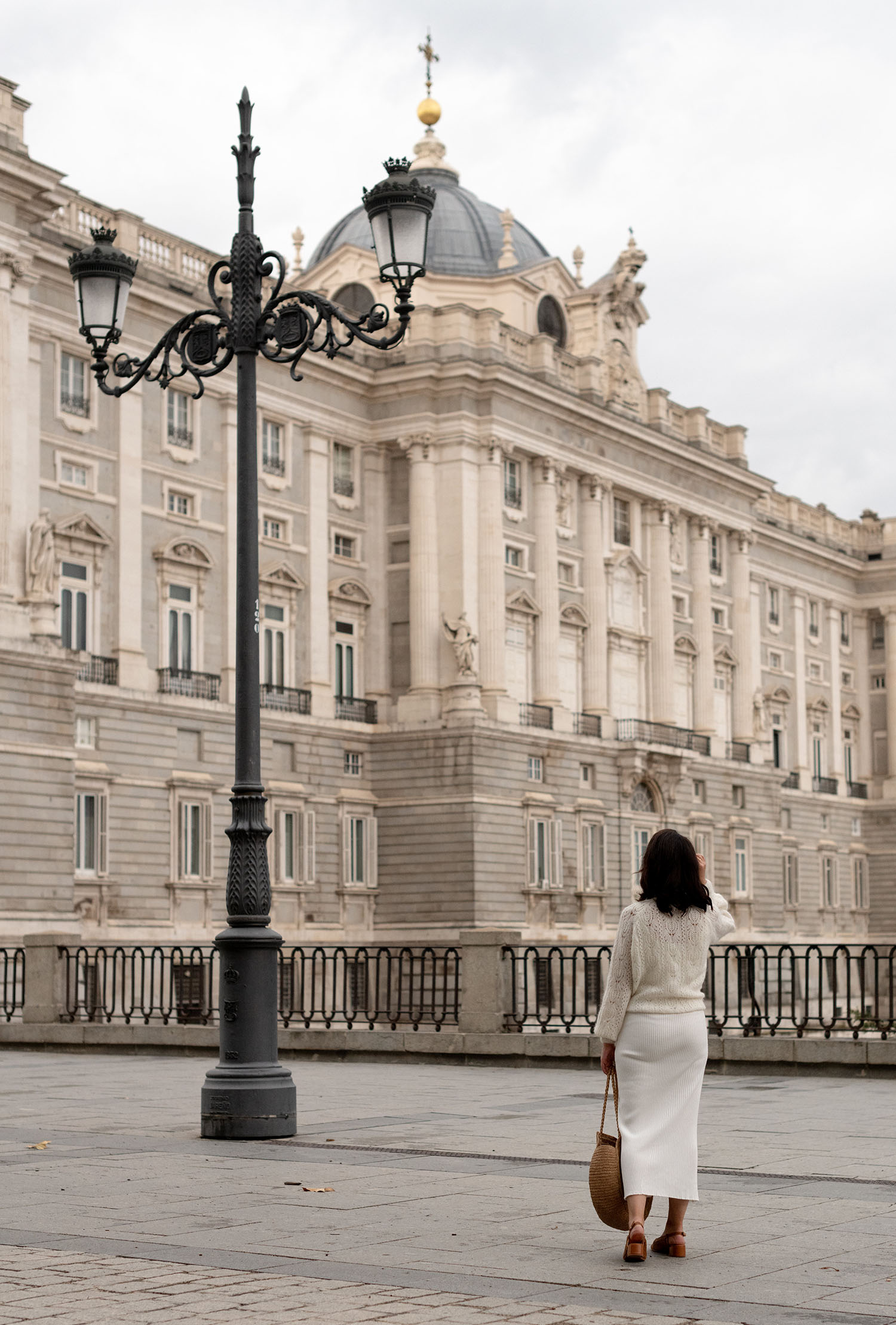
Mango dress
Sezane heels
Sezane bag
Celine sunglasses
Agape Studio necklace (c/o) (similar)
Linjer rings (c/o)
Agape Studio earrings (c/o) (similar)
Location: Palacio Real – Madrid, Spain
There are some cities, in my experience, where you can turn a corner and suddenly, everything changes. It happens in Rome, when you arrive at the stairs at the end of Via Nazionale and the Colonna Traiana, Altare della Patria and Monumento a Vittorio Emanuele II all abruptly come into view. And it happens in Madrid, when you pass through Plaza de Isabel II onto Calle de Arrieta and the royal palace appears on the horizon.
I could think of only one word, when I saw the palace in Madrid for the first time: “Wow.”
Sometimes, when we’re truly astonished, that reaction leaves us speechless. I’m rarely without an apt adjective, but on this rainy morning, none came to mind. All I could do was stare.
And when you look at buildings, consider their architecture. It will show you who built them. The royal palace in Madrid gives itself, and its architects, away instantly.
It makes sense that it should be so awe-inspiring. That was by design. Spain was a major colonial power in the eighteenth century. The nation was a force in the wider world, not to mention on the seas, in an era when western Europeans believed they ruled them. Construction of the palace began in 1738, on the site where the alcazar had stood until it burned down four years earlier. It continued until 1758. In the two centuries ahead of this, Spanish conquistadores, or conquerors, invaded South America in the name of their sovereigns, who viewed this as a divine right, but remained at home to govern while funding the creation their new colonies.
The rule of the Spanish kings spread all over the globe, and it was absolute. When they built a palace, the intent was that it should convey their power and might. Nothing was too big, or too grand. Or too intimidating.
The palace in Madrid is beautiful, but it isn’t just that – it’s daunting, too. The building takes up a huge swath of city blocks, which translates, on the inside to almost 1.5 square feet of space in more than 3400 rooms. It’s the scope of it, the combination of its sheer size and all the tiny details meticulously included, that makes it so staggering. I can’t fathom what it would be like to be so absolutely convinced of my own superiority that I could imagine a building like it, never mind compel people to construct it. But I tried, as I stood there looking at it. And because I couldn’t, I was simultaneously impressed and mildly terrified.
Which, of course, was exactly the point. It was a different time. What was normal then is not normal now. We can acknowledge that, and understand it. There’s no need to debate whether that very different understanding of normalcy rendered the acts committed in its name justifiable. They won’t change. The past is past, but those who don’t remember it invariably, unwittingly drag it into the present, thus repeating it.
The Bourbons, who won the Spanish war of succession after the Habsburgs left no heir, ruled the country in the eighteenth century. The royal palace in Madrid is their palace – the current royal family lives elsewhere. They believed, or at least they claimed, understanding it was in their interest to do so, that they’d been chosen by God to rule. And by extension, they assumed the entitlement of their forebears to appropriate the land of any people who weren’t well-armed enough to defend against an unexpected onslaught of their violence. We can see their legacy in the Philippines; in Mexico, Central and South America. But those places have evolved with time. The palace remains, as it always was, a testament to the people who built it.
When I turned onto Calle de Arrieta for the first time, I understood instantly the legacy that the Spanish Bourbons wanted to leave behind. The palace tells me who they were – and I believe them.
Happy Friday, lovey!! SO excited to chat today and catch up. As per usual… it feels like it’s been wayyy too long. And my gosh, I just love your little photo bomber. Haha! As for the palace? I can see why you were taken aback – it’s truly stunning and I love all the ornate details. Were you able to tour inside as well? I imagine the interiors are breathtaking! Sigh! xo
Hearted Life (life + style blog)